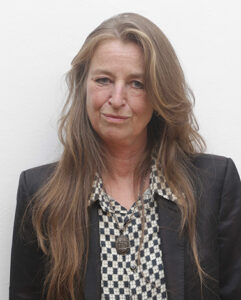
Dianne Hagen
1964
Eindhoven, the Netherlands
Hagen’s career features an extensive range of art practice: installations, sculptures, painting, drawing or short films.
Her oeuvre is very coherent and homogeneous, but at the same time very diverse, this seemingly contradiction is resulting in a body of work that is both visually and conceptually arresting.
No matter what material they are executed in, what characterises the work is the undermining of reason. They are by choice and conviction suggestive. Hagen confronts us with carefully staged situations where we find ourselves seduced to interpret. Seduced to the power we want to have to be able to interpret, appropriating the given situation and thus find self-recognition. But the power remains with the artwork, the artwork as an (resilient) object instead of subject. “Object and the image of the object mate in your private mind”. (quote DH 1994) Indicating the responsibility and importance of the spectator, who brings in his/her own associations, memories and past. Looking at art is by nature an individual reflection and has a contemplative character.
Where this interaction is the dominant de facto it is logical she doesn’t give individual titles to the work. This guidance towards one single identity is withheld. This attitude doesn’t come out of disrespect or idealistic belief of the visual over language. Throughout the years she has been using language as material, as part of the work. For example a work from 1997 that resembles a small stool. It is newly covered by reflecting golden plastic with, on top, a wide open woven pattern of white cotton bindings. On the crosswise white stripes the word YOU and I are printed. Because of the open structure you can see printed on the plastic the word OWN. I OWN YOU.
Or the work from 2005 that carries a clear reference to Marcel Duchamp. A woven shape of red and white thread is photographed. This photo is presented on a paper with the words état donné (given state) printed line after line as wallpaper.
The short film Cobblestone (2018, duration: 6.53) integrated a poem. And in 2023 she had a live performance to accompany her exhibition; combining her poems with a soundscape by DJ Berton. https://www.youtube.com/watch?v=ugS7EsprCMo&t=101s
The sculptures and installations are composed of different materials and assembled like a collage. In the same way she approaches paintings and drawings; they are constructed spaces often marked by patterns. Patterns aren’t innocent. Patterns and their colours talk about taste and time. Painting a pattern talks about painting itself. “I use paint to construct a space in between ecstasy and loss. Preferring a horizon instead of an opinion.”
Longing as an absence; cut loose from a desired identity and power as being in control are intertwined and no longer opposites. The mirror or an empty space are central recurring topics. Toying between the freedom for interpretation and the artist’s need to speak out. As Bart Verschaffel wrote in the catalogue of Green Eastern: ‘Each of these materials, formal elements and connections evoke primitive associations, constituting a whole that is experienced and felt rather than seen and understood.’
The work with the collaged letters Merci What more do you Want was conceived in the hospital recovering from a broken spine (2002) caused by a horse riding accident. It is still having multiple interpretations above the first (rather cynical) one of accepting the given situation. Precising the role of an artist or the role of an art work and the relation with the ‘other’. In a looped video on a screen placed under the collage she creates a ‘barok’ flower by scratching the golden sheet from behind. Like the chocolate box cover Merci is meant for, a gift indeed.
Already at the beginning of her career she received international acknowledgment and was represented by gallery Philip Nelson (Paris) until his demise. He has shown her work at all major international Art Fairs. In the Netherlands she is represented by Lumen Travo.
In 2006 she started living and working in Amsterdam and Delhi (India) until her partner Sanjeev Sinha died in 2020. Since then she works in Amsterdam only. She studied at the Rietveld Akademie and followed the two-year residency at the Rijksakademie in Amsterdam. Hagen exhibited her work in solo and group exhibitions in o.a. Stedelijk museum Schiedam (NL), STUK museum Leuven (Belgium), Villa Giulia–CRAA Centro Ricerca Arte Attuale (Verbania, Italy), W139 (Amsterdam), De Appel (Amsterdam), Museum Dhondt-Dhaenens (Belgium), Melly (Rotterdam, NL). Her works are in museums and private collections in The Netherlands, Canada, America, Belgium, France and India.
She has executed two public commissions in India.
Together with Sanjeev Sinha († 2020) she organized the international Art & World Peace project at the Buddhist pilgrimage village BodhGaya in the state Bihar in 2006, 2011 and 2017. Each of these editions culminated with the publication of a catalogue.